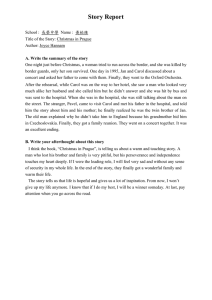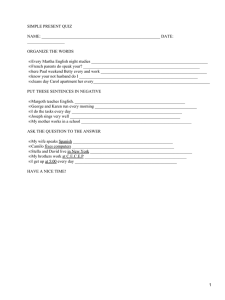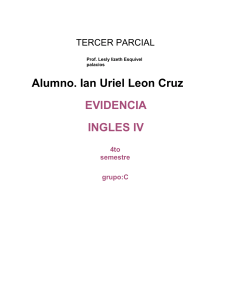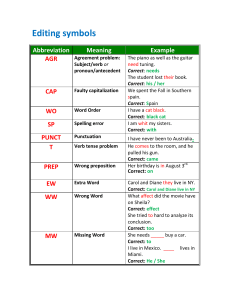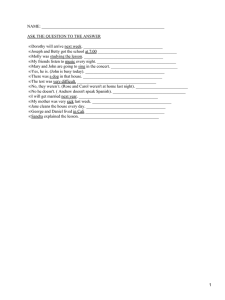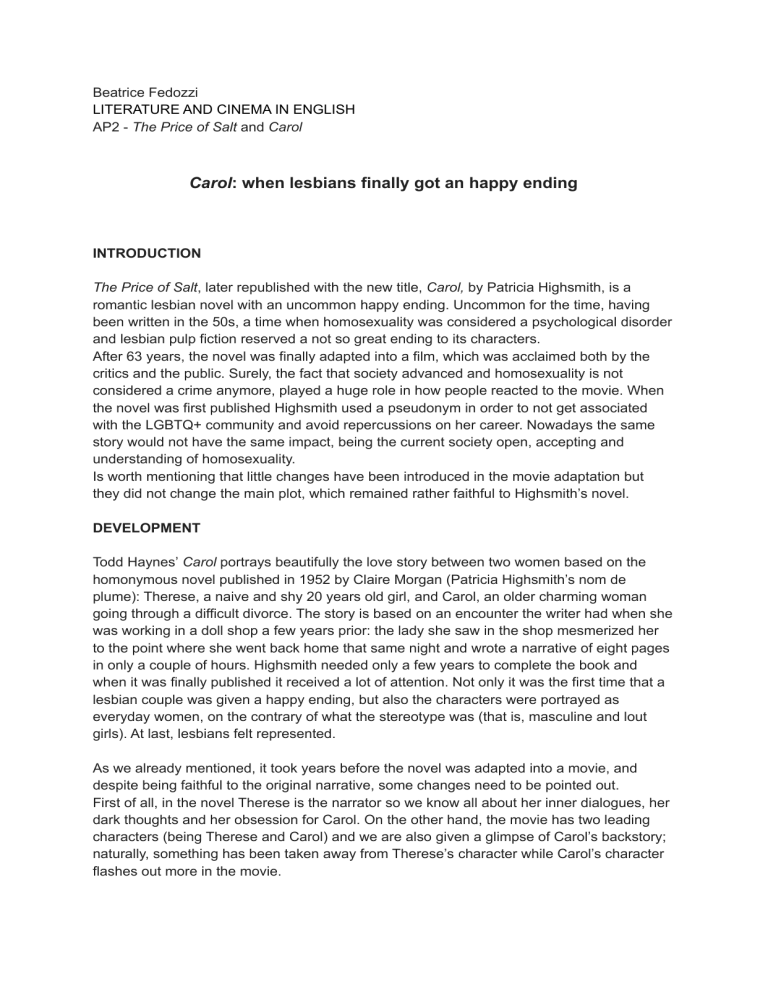
Beatrice Fedozzi LITERATURE AND CINEMA IN ENGLISH AP2 - The Price of Salt and Carol Carol: when lesbians finally got an happy ending INTRODUCTION The Price of Salt, later republished with the new title, Carol, by Patricia Highsmith, is a romantic lesbian novel with an uncommon happy ending. Uncommon for the time, having been written in the 50s, a time when homosexuality was considered a psychological disorder and lesbian pulp fiction reserved a not so great ending to its characters. After 63 years, the novel was finally adapted into a film, which was acclaimed both by the critics and the public. Surely, the fact that society advanced and homosexuality is not considered a crime anymore, played a huge role in how people reacted to the movie. When the novel was first published Highsmith used a pseudonym in order to not get associated with the LGBTQ+ community and avoid repercussions on her career. Nowadays the same story would not have the same impact, being the current society open, accepting and understanding of homosexuality. Is worth mentioning that little changes have been introduced in the movie adaptation but they did not change the main plot, which remained rather faithful to Highsmith’s novel. DEVELOPMENT Todd Haynes’ Carol portrays beautifully the love story between two women based on the homonymous novel published in 1952 by Claire Morgan (Patricia Highsmith’s nom de plume): Therese, a naive and shy 20 years old girl, and Carol, an older charming woman going through a difficult divorce. The story is based on an encounter the writer had when she was working in a doll shop a few years prior: the lady she saw in the shop mesmerized her to the point where she went back home that same night and wrote a narrative of eight pages in only a couple of hours. Highsmith needed only a few years to complete the book and when it was finally published it received a lot of attention. Not only it was the first time that a lesbian couple was given a happy ending, but also the characters were portrayed as everyday women, on the contrary of what the stereotype was (that is, masculine and lout girls). At last, lesbians felt represented. As we already mentioned, it took years before the novel was adapted into a movie, and despite being faithful to the original narrative, some changes need to be pointed out. First of all, in the novel Therese is the narrator so we know all about her inner dialogues, her dark thoughts and her obsession for Carol. On the other hand, the movie has two leading characters (being Therese and Carol) and we are also given a glimpse of Carol’s backstory; naturally, something has been taken away from Therese’s character while Carol’s character flashes out more in the movie. Secondly, in the book Therese is a theatre set designer while in the film she is an aspiring photographer and she eventually gets a job at the New York Times. Last but not least, the road trip. The novel follows more of their trip and the stops they make but the big change relies on when they get busted by a private investigator employed by Harge. Carol is now finding herself in a delicate situation: the tapes recording her promiscuous behaviour have, in fact, been sent to Harge to be used as evidence against her in order to get full custody of their daughter Rindy so she needs to go back home as soon as possible. In the movie, Carol flies back to New York while Therese is still asleep; when she wakes up she finds Abby (Carol’s old friend, as well as former lover), who will then drive Therese back home. In the book, though, Carol leaves and Therese finds herself stranded in a mid-Western city, waiting for who knows how long. Carol will call her only later to let her know that they have to end their relationship since she’s constantly under scrutiny; Therese proceeds to find a new job and home but she eventually goes back to New York, where she’ll reunite with Carol exactly like in the movie. In a way, we can say that these changes were made to adapt the story to the present time audience; as a matter of fact, I reckon that, for example, developing Carol’s character was an expedient to have a more rounded narrative and make the story work better on screen. Having two main characters work better sometimes and in this particular case, I think it was a great choice to give birth to Carol’s character as we know it. Not only do we get to see her point of view, but we also get more details about her life. For instance, her husband Harge only showed up once in the novel, whereas in the movie he was given more importance and we get to see him multiple times. The same goes for Therese’s job, which I believe has been changed because photography is more visual and easily understandable by the public rather than set designing. As for the third change, the only reason why I think it was made is the fact that the director preferred to cut a part out so that he could keep the movie rather short and the attention of the audience high. Long movies are hard to watch and anyway modifying a bit the course of events didn’t change the story. The Price of Salt had a tremendous success amongst lesbians when it was first published. At the time, homosexual love was forbidden and was depicted as a psychological disorder, hence falling in love with the same sex was not even an option. In the movie there’s a clear example about it: “Therese: I mean two people who just... fall in love. With each other. Say, a boy and a boy. Out of the blue. Richard: I don't know anyone like that. But I'll tell you this: there's always some reason for it. In the background. Therese: So you don't think it could just... happen to somebody, just... anybody? Richard: No. I don't. What are you saying? Are you in love with a girl? Therese: No.” Today, such conversation would not be controversial. We as a society have luckily advanced and we are accepting of every form of love (obviously there are exceptions, as there are for everything) and for this reason, the story wouldn’t have the same impact nor have the same significance if transported to the present day. In the 50s it was absurd to even think to be in a homosexual relationship and promiscuous behaviour was punished; today we celebrate love in all of its forms and many countries have already opened to same-sex marriages. More than homosexuality, nowadays would be important to talk about transgenders, asexuals and pansexuals (to mention some), since there is a lot of ignorance around these themes. CONCLUSION The Price of Salt before and Carol later, had a great impact on lesbian fiction and have been well received. At last, lesbians felt rightfully represented, something that was never done before the publishing of the novel in 1952. The movie adaptation Carol, equally acclaimed by the public, follows the plot of Highsmith’s novel, even though director Todd Hayne brought some minor changes to it in order to adapt it to the big screen. The same story wouldn’t probably have the same impact if transported to the present day, since being homosexual is not a big deal anymore and is definitely not considered an illness to be cured as it was fifty years ago. I wanna conclude with my favourite quote from the book, which sums up marvellously the real meaning of the story: love is unpredictable and comes in all of its forms. “Was it love or wasn't it that she felt for Carol? And how absurd it was that she didn't even know. She had heard about girls falling in love, and she knew what kind of people they were and what they looked like. Neither she nor Carol looked like that. Yet the way she felt about Carol passed all the tests for love and fitted all the descriptions.” ― Patricia Highsmith, The Price of Salt BIBLIOGRAPHY - “Carol”, Todd Haynes, 2015 “The Price of Salt”, Claire Morgan, 1952, Coward McCann.
